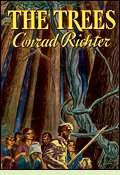|
The Treesby Conrad RichterReviewed by Margaret Donsbach As Sayward and her family descend and begin making a home of sorts, Richter brings readers right into the woods with them. We feel the father's restless energy, erecting log walls at an almost frenzied pace and then, roofless cabin half finished, trading axe for rifle and disappearing into the trees to return only at dusk, day after day, with "a skin or two wrapped around the choicest parts of the carcass." We feel the ailing mother's despair. "She had had her say and what good did it do her? The time to have set herself against this place was away back in the old state..." We feel the children's delight, swinging on vines "back and forward over logs that would have broken their backs had they ever let go." Weathering hardship and tragedy, Sayward learns a taciturn, compassionate wisdom. As other settlers filter into the area, she changes and the land changes. Lush in description, spare in judgment, Richter leaves us room to mourn the passing of the American wilderness even as we sympathize with the pioneer women's ache for civilization and its comforts - family and friends most of all. (1940; 154-175 pages in various editions) More about The Trees at Powell's Books or Amazon.com
Honey in the Horn by H.L. Davis (1935), about settlers on the Oregon frontier in the early twentieth century. More info The Way West by A.B. Guthrie, Jr. (1949), about a wagon train traveling west in 1846. More info Angle of Repose by Wallace Stegner (1971), about a retired historian's research into his grandparents' hard lives and enduring marriage as settlers in Grass Valley, California. More info
American Grit: A Woman's Letters from the Ohio Frontier edited by Emily Foster (2003). More info Trans-Appalachian Frontier: People, Societies and Institutions, 1775-1850 by Malcolm J. Rohrbough (1978). More info From Coastal Wilderness to Fruited Plain: A History of Environmental Change in Temperate North America from 1500 to the Present by Gordon G. Whitney (1994). More info
The Awakening Land
Early Settlement west and north of the Ohio River, a historical perspective at the Wayne National Forest website. Back to Novels of the American Old West
|
